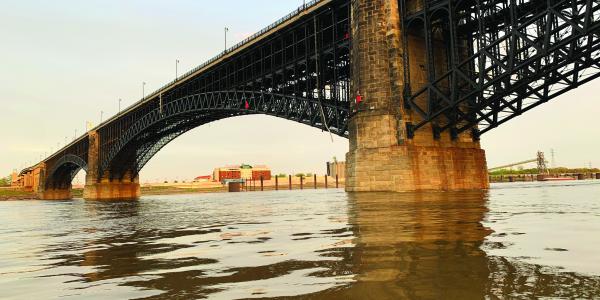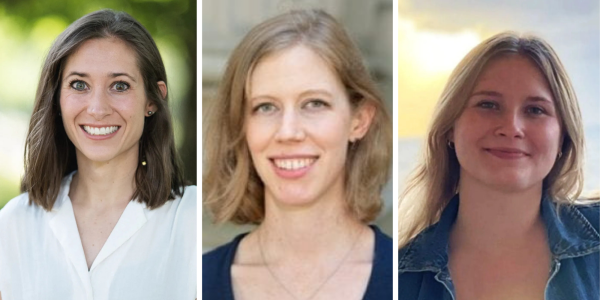Researchers in Arts & Sciences examine environmental injustice along waterways, shifting the current toward a more equitable future.
I. At the confluence of climate change and environmental justice, with geomorphologist Claire Masteller
II. The sacred and the polluted, with art historian Ila Sheren
III. The neglected disease, with sociocultural anthropologist Theresa Gildner
IV. Understanding history through a river, with historian Robin McDowell
In late July, floodwaters surged through the St. Louis region, pouring into homes, businesses, and public transportation corridors. Images from the historic rainfall filled national news outlets in the following days, but the reports missed some crucial context.
“Everyone heard about the major flood that happened in St. Louis, but nobody knows about the constant flooding happening in Centreville, just 20 minutes away,” said Claire Masteller, assistant professor of Earth and planetary sciences. “That disparity is environmental injustice.”
From fires in the western United States to flooding in the Midwest to polluted lands and waterways across the globe, climate-driven crises and neglected environmental hazards often exacerbate existing inequalities as lower-resourced areas and communities of color face the brunt of these threats.
Recognizing this reality, a large and growing number of Arts & Sciences faculty members across the humanities, natural sciences, and social sciences identify environmental justice as a critical goal of their work. Four of these researchers discuss how they’re diving in.
I. At the confluence of climate change and environmental justice

Masteller, a geomorphologist, is working with communities in the St. Louis metro area to ascertain what risks they face as the local landscape evolves, particularly when it comes to moving water. In a NASA-funded community study, Masteller will be modeling urban flooding in Centreville, Illinois, integrating satellite data with flood data gathered by community partners.
“Centreville isn’t unique in the sense that it experiences flood events, but it has a confluence of issues that have led to environmental injustice,” Masteller said. “The community is predominantly Black, it’s one of the lowest income communities in the state of Illinois, and they experience severe flooding after only 30 minutes of rain. Even when you account for the natural risks that come from living in a floodplain, it’s clear that the management and engineering decisions in Centreville have not been sufficient to handle the staggering amount of water piling up on this landscape.”
“Our landscapes are the place where climate change is ultimately going to be brought to bear, and where it’s going to affect human lives.”
As a geomorphologist, Masteller is an expert on landscapes. Her research focuses on how landscapes form and change. She aims to better understand why Earth’s surface looks the way it does, how it might respond to future changes in weather and climate, and, critically, how landscape dynamics impact people living in those areas. In ongoing collaborative research funded by the National Science Foundation, Masteller combines experimental studies of river erosion in her lab with historical flood data and geospatial data from real river channels to quantify how sensitive rivers are to changes in climate.
“Our landscapes are the place where climate change is ultimately going to be brought to bear, and where it’s going to affect human lives,” Masteller said. “The people who live on these landscapes will have to endure the consequences of those changes.”
Climate change has obvious implications for environmental justice, she says: Not all communities will be impacted by the consequences of climate change equally, nor will affected communities receive equal support from governments.
For Centreville residents, the consequences of ongoing flooding spill over into social, economic, and health issues. Floodwaters back up sewer systems, limiting access to clean drinking water; repeated water damage to homes can be costly to repair and can reduce property valuations, making it nearly impossible for residents to sell their homes and relocate.
Masteller plans to deliver findings from her Centreville project to local project partners with the aim of defining flood risk more accurately, providing evidence for infrastructure improvements needed to reduce flooding, and, ultimately, helping to secure a more equitable future for the community.
II. The sacred and the polluted
Ecological art, a genre fueled in part by environmental disasters, can elicit a reaction that art historians call the “toxic sublime” — an uncomfortable pleasure provoked by looking at gorgeous large-scale landscape photographs of heavily polluted sites. These photographs frequently depict harsh environments as both starkly beautiful and hazardous.

People — particularly those who live near these wastelands — are notably absent from these photographs, says Ila Sheren, associate professor of art history and archaeology. Sheren is writing a book about digital art that flips that template by placing people at the center of depictions of ecological disaster.
“Because of the way that the global art market works, when we look at artwork that’s dealing with the Global South, these artists are often making art not for local audiences but for people living half a world away,” Sheren said.
In her art history courses at WashU, Sheren regularly shows students the 2015 short video Manthan by artist Vibha Galhotra. Her students often express mystification at the video’s emphasis on the ritual pollution of a white sheet, which is dipped in the Yamuna River in India and covered in black sludge by the video’s end.
Manthan serves as a powerful teaching tool because it reveals an alternative to the “toxic sublime.” Galhotra made the film for both local and international audiences, and the artist does not depict the Yamuna as a polluted site devoid of people. Instead, she “communicates in the language of that place” by placing local knowledge and bodies at the center of her narrative.

Manthan shows four men driving rafts in the Yamuna River to a floating mound of trash and debris. Their actions reference the Samudra Manthan episode in Hindu mythology, in which gods and demons briefly join together to churn an ocean and create the nectar of immortality. As a byproduct, they pollute the ocean with a poison that threatens to destroy all of existence. Another god, Shiva, swallows the poison to prevent the destruction.
“I’m really intrigued by the idea of the kinds of messages that these artists are creating and which audiences they privilege in their art,” Sheren said. “That question reveals a lot about how art engages with larger discussions about human inequality and environmental justice.”
III. The neglected disease

Nobody wants to talk about parasites. Compared with other types of disease, even the medical scientific community within the U.S. has largely ignored parasitic infections for decades. But Theresa Gildner, assistant professor of anthropology, and her collaborators are paddling upstream against that trend.
Gildner studies parasites that spread when contaminated water or soil brings fecal matter into contact with humans; this contamination often occurs in lower-income neighborhoods, which experience frequent flooding and associated sewer backups.
“There seems to be a general lack of awareness in many parts of the country that this is even a concern,” said Gildner, “because the infections tend to largely impact less affluent communities that don’t have resources to draw attention to these issues in the first place.”
When Gildner tested samples from schoolchildren in Mississippi, she found that 25% of the classroom had signs of parasitic infection, and a startling 80% had clinically elevated intestinal inflammation — a higher rate than her earlier studies found in Ecuador and other parts of the world. She’s now investigating whether the same issues affect neighborhoods with wastewater management concerns close to Washington University.
“There seems to be a general lack of awareness in many parts of the country that this is even a concern because the infections tend to largely impact less affluent communities that don’t have resources to draw attention to these issues in the first place.”
In collaboration with community partners and with support from a newly launched seed grant program in Arts & Sciences called SPEED (Seeding Projects for Enabling Excellence & Distinction), Gildner began data collection in the Metro East this summer. The grant provides resources to conduct sophisticated lab analyses of soil and fecal matter; in collaboration with Liz Mallott, assistant professor of biology, she will examine the samples for parasite DNA. The grant also provides increased opportunities for community outreach. In Mississippi, Gildner hired nurse practitioners to build a database for study participants that will track incidents of parasitic infection and provide information and resources for medical treatment.
Gildner views her work detecting parasites as part of a larger push for environmental justice and more equitable health outcomes. “If you’re in a community where you’re exposed to these conditions that can contribute to poor health over time, that might impact your performance in school or lead to difficulty being able to gain more economic mobility and opportunities,” said Gildner.
“It’s a vicious cycle. Because the parasites are in the environment, even if you’re treated once you might be continually reinfected, and this might contribute to existing health and wealth inequities,” she said. “There are serious financial costs and long-term physical consequences if you’re not making structural changes to try to prevent people from being exposed in the first place.”
IV. Understanding history through a river

They knew they were getting close when they saw the bubbles. Shortly after came the smell. As six students, led by Robin McDowell, assistant professor of African and African-American studies, raised and dipped wooden paddles into the Mississippi River, they slowly approached the Mary Meachum Freedom Crossing. The students had read about Mary Meachum’s attempt in 1855, beginning at this location, to ferry nine enslaved people across the Mississippi to freedom in Illinois. But seeing the site in person — totally inaccessible except from the river and marked by industrial waste pouring into the water — raised some perplexing questions.
“It gets to the historical roots of environmental racism,” said McDowell. “We can track contaminants in the water, but how do you measure historical desecration? What does it mean when you are continuously disrespecting what is really a sacred piece of Black history, the history of the city, and the history of the United States?”
“We can track contaminants in the water, but how do you measure historical desecration? What does it mean when you are continuously disrespecting what is really a sacred piece of Black history, the history of the city, and the history of the United States?”
McDowell planned the Mississippi River canoe trip, which began in north St. Louis and ended at the St. Louis Arch, as the culmination of her advanced seminar “Black Geographies: Space, Place, and Ecologies of Power.” In the course and in her own research, McDowell views the Mississippi as a powerful vantage point from which to examine the ways that historical and contemporary patterns of industry and toxicity affect Black and lower-income communities. Her current book project focuses on the long history of environmental injustice in southern Louisiana, a site that shares St. Louis’s ties to the Mississippi.
In “Black Geographies,” McDowell offers an interdisciplinary approach to the study of environmental justice. The course invites students to plan their own lectures and field trips to historic sites, and they hear from current-day community organizers alongside discussions of historical events. The method, McDowell says, acknowledges that “the history of the bonds between race and environment” can’t be adequately approached through any single, neatly defined subject area.
“How do universities prepare young people for a world in crisis?” McDowell asked. “I’d like to think it’s through these interdisciplinary and experiential courses, where students become politically, socially, and economically knowledgeable. We’re fundamentally preparing people for the world they inhabit.”





